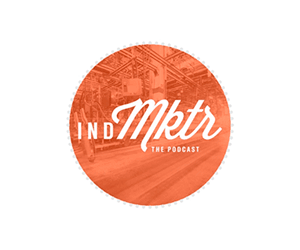Why are manufacturing case studies so important?
Well, the industrial buying trends have been pointing in this direction for years: You would be wise to have customer-centric copy on your website for when prospects visit to do their research. But the pace of the digital content revolution has surpassed even what some of us in the business have expected.
The typical B2B buying process now involves six to 10 decision-makers, according to Gartner. Each person is independently scouring online for five to six content pieces to bring to the table.
And what do these prospects want to see? High on that list will be how your product, service, or solution has worked for others. Which brings us to the topic on hand: manufacturing case studies. Why don’t we see more of these in the industrial marketing ecosystem?
In the latest edition of the Industrial Marketer podcast, co-hosts Joey and Nels discuss how case studies and success stories are under-utilized and under-appreciated as a content marketing tool.
What Is a Manufacturing Case Study?
Many marketing terms have lost their original meaning and been diluted in application.
A white paper, for example, has its origins in government and academia as an in depth report on policy or research findings. Now the term “white paper” signals little more than promotional information about technical features or how a product or service functions as a solution.
The “case study” originated in clinical medicine, but it became more synonymous with business when graduate business schools began digging into why things worked, or why they didn’t work. A traditional case study drafted for manufacturing marketing purposes includes:
- Background
- Challenge
- Solution
- Results
The power of a case study is in the outcome, with key statistics or metrics that demonstrate the real-world proof of your solution in the marketplace. And therein lies the rub.
Hurdles — Real & Imagined — to Producing Case Studies
In recent memory, it certainly feels like the manufacturing community has increased the number of hurdles to doing case studies and raised the height of those hurdles. Ask your clients for information to do a manufacturing case study and you are likely to hear objections around:
- Proprietary information – This includes trade secrets about products and materials but also who is doing work for whom. Many manufacturers will tell you the less competitors know the better.
- Performance metrics – Clients are hesitant to share financial information about anything, but many are now hesitant to share information about cycle times, error rates or anything related to production.
- Contact terms with that client – The belief is that if a client knows the details of how much your innovation has reduced cycle times and increased your margin, they will use that information against you in the next negotiation.
The results have meant a near death knell for the traditional manufacturing case study. Nowadays, instead of a metric-filled recap that could be a digital marketer’s dream content, what we see are vague references to saving time and money for an entity in a large industrial sector.
So, what are industrial marketers to do if they want to create manufacturing case studies that will land with their target audiences?
Reframe Case Studies as Success Stories
For practical purposes, what we really are talking about in industrial marketing circles when we say “case studies” is offering real-world proof of success with your solution. We are talking about success stories and even testimonials.
In lieu of a traditional case study full-combo platter of company name, solution and real metrics, industrial marketers should be creative about telling success stories in any way they can. Find ways to get your clients to say yes to bragging on their successes. For example, you can reduce the format to be framed around two key categories: the challenge and the solution.
Here is a great way to frame the challenge: “Our (industry) customer challenged us with designing and manufacturing a (application) to achieve (objective).” This approach can be replicated for many situations. Be specific about what you are being asked to do. That’s what is important to prospects. Play to your strengths. Use examples that you know will resonate with your ideal customers.
For solutions, be clear about what you were able to accomplish. You can describe specs or dimensions or materials without giving away trade secrets. In the end, you might not be able to say much more regarding results than, “All design specifications were met.” But even that can be a powerful statement to a prospect. You were asked to help a client do something, and you did. If you can’t go into details about the results, go into details about how you met the challenge.
Leverage Customer Testimonials
Don’t underestimate the power of a customer testimonial, especially in video format. Work with your customer to get the most possible value from a testimonial. Listen to what they want to say, and encourage them to address the areas that are important to you. Maybe you develop a script for them.
A testimonial is like a reference. Get a range of testimonials, from new customers to your most loyal. Map out a list of possible testimonials — e.g., one customer might be able to address how you improved their cycle time. Another customer might talk about how you helped with quality. Maybe you solved a vexing issue for a new customer.
A group of testimonials can tell a powerful story. And you also could be sitting on a gold mine of nuggets that you could sprinkle throughout your website in FAQs, on product pages, and on the main page each industry you serve. Don’t forget: More people than ever are researching your products and services. In the absence of traditional manufacturing case studies, success stories and testimonials can help get them farther along the buying journey.
Listen to the Podcast for More on Manufacturing Case Studies
For more insights into how to implement a CRM in a way that will help you drive growth, tune into Episode 28 of the Industrial Marketer podcast.
Subscribe to the Industrial Marketer Podcast
The Industrial Marketer podcast comes out twice a month. To subscribe, visit our Buzzsprout show page and select your podcast platform of choice.
And if you have any ideas for topics you’d like us to cover on the podcast — or here on the Industrial Marketer website — send us a message on Facebook or Twitter and let us know!




